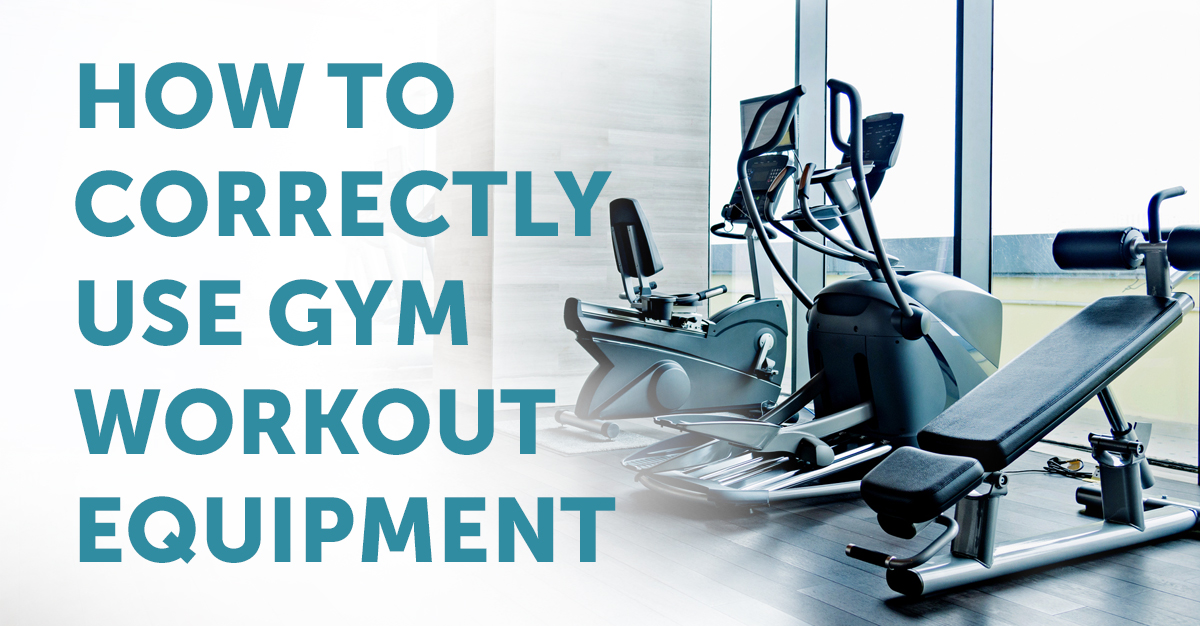Are you ready to get the most out of your workouts? Knowing how to use fitness equipment properly can make all the difference in reaching your goals faster and staying injury-free.
Whether you’re new to the gym or have some experience, mastering the right techniques will boost your confidence and results. Keep reading, and you’ll discover simple tips that help you use common machines and tools effectively—turning your exercise routine into a powerful, rewarding experience.
Your body will thank you!

Credit: www.wikihow.com
Choosing The Right Equipment
Choosing the right fitness equipment is key to a good workout. The right tools help you reach your goals faster. They keep you motivated and reduce injury risks.
Many options exist, so take time to pick what fits you best. Consider your fitness level, space, and budget. This helps you avoid wasting money or effort.
Assessing Your Fitness Goals
Start by knowing what you want to achieve. Do you want to build strength, lose weight, or increase endurance? Each goal needs different equipment. Strength training needs weights or resistance bands. Cardio goals call for treadmills or stationary bikes. Clear goals guide you to the best choices.
Types Of Fitness Equipment
Equipment falls into three main groups: cardio, strength, and flexibility. Cardio machines raise heart rate and burn calories. Strength tools help build muscle and tone your body. Flexibility gear improves stretching and balance. Choose equipment that matches your goals and interests. This keeps workouts fun and effective.
Budget Considerations
Set a spending limit before buying. Basic equipment like dumbbells or jump ropes cost less. Machines like ellipticals or rowing machines are pricier. Think about quality and durability too. Sometimes spending more saves money over time. Look for deals or second-hand options to save.

Credit: ptandme.com
Setting Up Your Workout Space
Setting up your workout space is important for a good exercise routine. A well-arranged area helps you stay motivated and safe. Choose a spot with enough room to move freely. Make sure the space fits your fitness equipment and allows easy access. A clear and tidy area makes workouts more enjoyable.
Safety Tips
Check that all equipment is stable before use. Keep cords and weights out of walking paths. Use non-slip mats to prevent falls. Make sure the floor is clean and dry. Follow the equipment instructions carefully. Avoid overcrowding the space to reduce injury risk.
Organizing Equipment
Place heavier items on lower shelves or racks. Store small equipment like dumbbells and bands in bins or baskets. Keep frequently used items within arm’s reach. Arrange equipment by type for easy selection. Label storage spots to maintain order. Regularly tidy the area to avoid clutter.
Creating A Comfortable Environment
Ensure good lighting for better visibility. Open windows or use fans for fresh air. Add a soft mat or rug for comfort. Choose a quiet spot to focus better. Adjust the room temperature to stay cool. Personalize the space with motivational posters or plants.
Using Cardio Machines
Cardio machines help improve heart health and burn calories. They are easy to use and fit many fitness levels. Using them right brings better results and lowers injury risk.
Treadmills
Stand on the side rails before starting the treadmill. Press the start button and begin walking slowly. Use the handrails for balance if needed. Increase speed step by step for comfort. Keep your posture straight and look forward. Avoid holding the console while running. Stop the machine by pressing the stop button. Step off carefully once it stops.
Stationary Bikes
Adjust the seat height to keep your knees slightly bent. Place your feet on the pedals and hold the handlebars. Start pedaling at a slow pace. Change resistance to make pedaling easier or harder. Keep your back straight and relax your shoulders. Breathe evenly during the ride. Stop pedaling and lower resistance before getting off.
Ellipticals
Step onto the pedals and hold the handles. Begin moving your feet in a smooth, circular motion. Use the handles to work your upper body. Adjust the resistance to match your strength. Keep your body upright and avoid leaning forward. Move steadily and control your speed. Press the stop button before stepping off.
Strength Training Tools
Strength training tools help build muscle and improve body strength. These tools target different muscle groups and allow varied workouts. Using the right equipment can make your exercises safe and effective. Below are common strength training tools you can use.
Free Weights
Free weights include dumbbells and barbells. They allow natural movement during exercises. You can lift them while standing or sitting. Start with light weights to learn correct form. Increase weight gradually to avoid injury. Free weights improve balance and coordination.
Resistance Bands
Resistance bands are stretchy and portable. They create tension to work your muscles. You can use them for arms, legs, and core exercises. Bands come in different resistance levels for beginners to advanced users. They are gentle on joints and easy to carry.
Weight Machines
Weight machines guide your movement with fixed paths. They often have adjustable weights and seats. Machines help beginners learn proper technique safely. They target specific muscles like chest, back, or legs. Always adjust the machine to fit your body size.
Proper Form And Technique
Proper form and technique are key to safe and effective workouts. Using fitness equipment correctly helps prevent injuries. It also makes exercises more effective. Good form targets the right muscles and improves strength. Poor technique can cause pain and slow progress.
Learning the correct movements takes practice. Focus on control and steady motions. Avoid rushing through exercises. Listen to your body and stop if you feel pain.
Common Mistakes To Avoid
Many people lift weights too fast. This reduces muscle engagement and increases injury risk. Avoid locking your joints at the end of a movement. Keep your core tight to support your back. Do not let your knees cave inward during squats. Using too much weight often causes bad form. Start lighter and build strength gradually.
Tips For Beginners
Start with simple machines before free weights. Learn how each machine works and what muscles it targets. Use slow, controlled movements to build good habits. Rest between sets to avoid fatigue. Ask a trainer or experienced friend to check your form. Focus on breathing steadily throughout each exercise. Warm up before exercising and cool down after.
Using Mirrors And Video Feedback
Mirrors help you see your posture and alignment. Check your form from different angles during workouts. Use your phone to record exercises for later review. Compare your movements to tutorial videos or instructions. This helps spot errors and improve technique. Small adjustments make big differences in results and safety.
Creating A Workout Routine
Creating a workout routine helps you use fitness equipment effectively. It keeps your exercise plan clear and focused. A good routine balances different types of workouts. It fits your schedule and lets you see progress over time.
Balancing Cardio And Strength
Include both cardio and strength exercises in your routine. Cardio boosts heart health and burns calories. Strength training builds muscles and improves endurance. Use machines like treadmills for cardio and weights for strength. Aim for at least three cardio sessions and two strength sessions each week.
Scheduling Rest Days
Rest days let your muscles recover and grow. Avoid working the same muscle groups two days in a row. Plan rest days after intense workouts. Light activities like walking or stretching are okay on rest days. Proper rest lowers injury risk and improves performance.
Tracking Progress
Keep a workout journal or use a fitness app. Record exercises, weights, and time spent on machines. Track how you feel after each session. Review your progress every two weeks. Adjust your routine based on your results and goals.
Maintenance And Care
Taking care of fitness equipment helps it last longer and work better. Regular maintenance keeps machines safe and smooth. It also saves money by avoiding big repairs.
Simple steps help keep your gear in top shape. Clean, check, and know when to replace parts. These habits protect your investment and improve your workout experience.
Cleaning Equipment
Wipe machines after each use to remove sweat and dust. Use a soft cloth with mild soap and water. Avoid harsh chemicals that can damage surfaces. Clean handles, seats, and screens carefully. Clean equipment stays fresh and prevents germs from spreading.
Regular Inspections
Check machines weekly for loose bolts or worn parts. Listen for strange noises during workouts. Test moving parts to ensure smooth motion. Tighten screws and lubricate joints as needed. Early fixes stop small issues from becoming big problems.
When To Replace Gear
Replace parts that show cracks, rust, or heavy wear. Stop using equipment if it feels unstable or unsafe. Follow manufacturer guidelines for replacing belts and cables. Old gear can cause injuries and reduce workout quality. Timely replacement keeps your routine safe and effective.

Credit: www.wikihow.com
Staying Motivated
Staying motivated helps you keep using fitness equipment regularly. It is easy to start strong but hard to keep going. Motivation pushes you through tough days and busy schedules. Small changes can make a big difference in how you feel about workouts.
Setting Achievable Goals
Set clear and simple goals for your fitness journey. Choose targets that are easy to reach at first. For example, aim to use the treadmill for 10 minutes daily. Achieving small goals builds confidence and keeps you moving forward. Update your goals as you improve to stay challenged.
Using Fitness Apps
Fitness apps track your progress and remind you to exercise. Many apps offer workout plans and tips for equipment use. They help you stay organized and focused on your goals. Some apps show your progress with charts and badges. This visual feedback motivates you to continue your routine.
Joining Support Communities
Support communities connect you with others who share your goals. You can share tips, ask questions, and celebrate wins. Being part of a group reduces feelings of loneliness. Encouragement from others helps you stay committed. Look for online forums or local fitness groups to join.
Frequently Asked Questions
What Is The Best Way To Start Using Fitness Equipment?
Begin with a warm-up to avoid injury. Start with light weights or low resistance. Learn proper form before increasing intensity. Follow equipment instructions carefully to maximize benefits and safety.
How Often Should Beginners Use Fitness Equipment?
Beginners should use fitness equipment 3 times a week. Allow rest days between sessions for muscle recovery. Gradually increase frequency as strength and endurance improve for optimal results.
How Do I Choose The Right Fitness Equipment?
Select equipment that matches your fitness goals and skill level. Consider space, budget, and ease of use. Research product reviews and seek professional advice if unsure.
Can Improper Use Of Fitness Equipment Cause Injuries?
Yes, improper use can lead to strains or serious injuries. Always follow instructions, maintain proper form, and avoid overexertion. Seek guidance from trainers when needed.
Conclusion
Using fitness equipment can help you stay healthy and strong. Start slow and learn how each machine works. Always keep safety in mind to avoid injuries. Mix different exercises to keep your workouts fun. Regular practice will improve your fitness step by step.
Enjoy the process and celebrate small progress. Fitness equipment can fit any goal or level. Stay consistent and listen to your body’s needs. You have what it takes to get fitter every day. Keep moving, stay positive, and make fitness part of your life.
